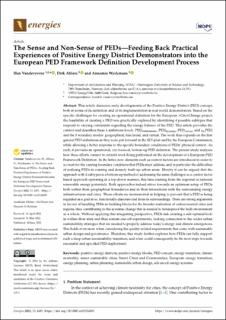| dc.contributor.author | Vandevyvere, Han Hendrik B. | |
| dc.contributor.author | Ahlers, Dirk | |
| dc.contributor.author | Wyckmans, Annemie | |
| dc.date.accessioned | 2022-12-07T13:28:48Z | |
| dc.date.available | 2022-12-07T13:28:48Z | |
| dc.date.created | 2022-08-11T21:50:09Z | |
| dc.date.issued | 2022 | |
| dc.identifier.citation | Energies. 2022, 15 (12), . | en_US |
| dc.identifier.issn | 1996-1073 | |
| dc.identifier.uri | https://hdl.handle.net/11250/3036394 | |
| dc.description.abstract | This article discusses early developments of the Positive Energy District (PED) concept, both in terms of its definition and of its implementation in real world demonstrators. Based on the specific challenges for creating an operational definition for the European +CityxChange project, the feasibility of creating a PED was practically explored by identifying 4 possible subtypes that respond to varying constraints regarding the energy balance of the PED. This article provides the context and describes these 4 ambitions levels: PEDautonomous, PEDdynamic, PEDvirtual, and PrePED; and the 3 boundary modes: geographical, functional, and virtual. The work thus expands on the first general PED definitions as they were put forward in the SET-plan and by the European Commission, while allowing a better response to the specific boundary conditions of PEDs’ physical context. As such, it provides an operational, city-focused, bottom-up PED definition. The present study analyses how these efforts connect to current work being performed on the development of a European PED Framework Definition. In the latter, new elements such as context factors are introduced in order to account for the varying boundary conditions that PEDs must address, and in particular the difficulties of realising PEDs in existing and densely built-up urban areas. Hereby it can be argued that the approach with 4 subtypes is a bottom-up method of addressing the same challenges as a context factor based approach operating in a top-down manner, this time starting from the regional or national renewable energy potentials. Both approaches indeed strive towards an optimum setup of PEDs both within their geographical boundaries and in their interactions with the surrounding energy infrastructures and cities. These efforts are instrumental in helping to prevent that a PED is being regarded as a goal in se, functionally disconnected from its surroundings. There are strong arguments in favour of handling PEDs as building blocks for the broader realisation of carbon neutral cities and regions, thus contributing to the systemic change that is needed to futureproof the built environment as a whole. Without applying this integrating perspective, PEDs risk creating a sub-optimal lock-in within their sites and thus remain one-off experiments, lacking connection to the wider urban sustainability strategies that are needed to properly address today’s energy and climate emergencies. This holds even more when considering the quality-related requirements that come with sustainable urban design and governance. Therefore, this study further explores how PEDs can fully support such a deep urban sustainability transition, and what could consequently be the next steps towards successful and upscaled PED deployment. | en_US |
| dc.language.iso | eng | en_US |
| dc.publisher | MDPI | en_US |
| dc.relation.uri | https://www.mdpi.com/1996-1073/15/12/4491 | |
| dc.rights | Navngivelse 4.0 Internasjonal | * |
| dc.rights.uri | http://creativecommons.org/licenses/by/4.0/deed.no | * |
| dc.title | The Sense and Non-Sense of PEDs — Feeding Back Practical Experiences of Positive Energy District Demonstrators into the European PED Framework Definition Development Process | en_US |
| dc.title.alternative | The Sense and Non-Sense of PEDs — Feeding Back Practical Experiences of Positive Energy District Demonstrators into the European PED Framework Definition Development Process | en_US |
| dc.type | Peer reviewed | en_US |
| dc.type | Journal article | en_US |
| dc.description.version | publishedVersion | en_US |
| dc.source.pagenumber | 16 | en_US |
| dc.source.volume | 15 | en_US |
| dc.source.journal | Energies | en_US |
| dc.source.issue | 12 | en_US |
| dc.identifier.doi | https://doi.org/10.3390/en15124491 | |
| dc.identifier.cristin | 2042554 | |
| dc.relation.project | EC/H2020/824260 | en_US |
| cristin.ispublished | true | |
| cristin.fulltext | original | |
| cristin.qualitycode | 1 | |

